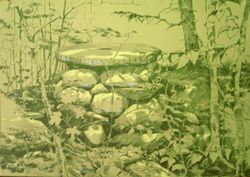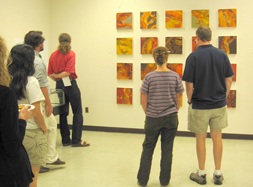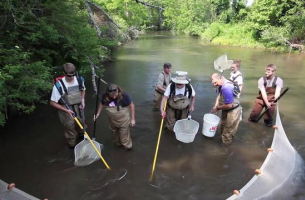You are here
Arts and Humanities
 History and Approach
History and Approach
The Harvard Forest has a deep history of incorporating environmental literature, history, photography, and fine art with scientific research to characterize past landscapes, depict future scenarios, and educate a range of audiences. In addition to the exquisite dioramas of the Fisher Museum, our arts and humanities work is two-fold.
- The first is an increased focus on interdisciplinarity in our instructional offerings.
Presentations and workshops by artists, historians, botanical illustrators, and writers enrich students' perspectives on landscape and global change.
- The second is a burgeoning effort to bring artists to the Forest to conduct inquiry on long-term ecological research sites alongside scientists.
This work has been supported by the Long-Term Ecological Research (LTER) Program of the National Science Foundation. Research sites across the country are actively engaged in this work. To learn more about the network, visit the LTER Arts & Sciences page. Artists interested in doing new work at the Forest may apply for a formal research fellowship via our Charles Bullard Fellowship program.
Project News

- Three Harvard Forest ecologists are featured in a new online course for educators, focused on the intersection of poetry and the environment, launched in spring 2019 as part of the Poetry in America project.
- A new sculpture installation by 2016-2017 Bullard Fellow David Buckley Borden and Harvard Forest Senior Ecologist Aaron Ellison, called Warming Warning, is on view at the Harvard Farm as of winter 2019. Previously, it was on view at Harvard University's highly visible Science Center Plaza, from October 19 through December 7, 2018.
- A field-based installation also by Buckley Borden and Ellison, called Hemlock Hospice, was embedded for public view in the Prospect Hill research tract of the Harvard Forest from October 2017 to November 2018 (read a Boston Globe feature here).
- Photographer John Hirsch published the 2017 book, And Again: Photographs from the Harvard Forest (Harvard U. Press; see reviews reviews), with a focus on the Forest's Long-Term Ecological Research Program.
- The culmination of 2013-2014 Bullard Fellow Lynda Mapes' work at the Forest is the 2017 book, Witness Tree: Seasons of Change with a Century-Old Oak (Bloomsbury Publishing; see a review here, podcasts here, here, and a video).
- Work by 39 artists from 11 LTER sites, including six artists from the Harvard Forest, was the focus of an Ecological Reflections exhibit at National Science Foundation (NSF) headquarters in Arlington, Virginia. The exhibit, “Sense of Place in Changing Places” ran February through June, 2013.
- A multimedia exhibit featuring work by 2011-2012 artist-in-residence Roberto Mighty was on display in the Fisher Museum in fall 2012.
- An online feature, Ghosts in the Forest, highlights work by 2010-2011 Bullard Fellow and artist-in-residence, Debby Kaspari.
Artists in Residence
2016-2017 Bullard Fellow David Buckley Borden is an interdisciplinary artist and designer, collaborating through 2018 with the Forest's world-class ecologists on boundary-shattering projects involving creative cartography, speculative design, and landscape installation.
In 2013-2014, veteran Seattle Times reporter Lynda Mapes spent a year at the Forest working on a book that tells the story of global change from the perspective of one red oak tree at the Harvard Forest. Learn more on the Witness Tree page.
Debby Kaspari, a 2011 Bullard Fellow and the Forest's first long-term artist-in-residence, explored themes of land use history and ecological legacies. Her residency included workshops, presentations for students and the public, and exchanges with other artists, historians, and scientists.
Support for digital multimedia artist Roberto Mighty includes both an art installation and film on the relationship between historical Native Americans and local forests, and se veral web-based ecological outreach videos.
veral web-based ecological outreach videos.
In two 1-week artist residencies in 2010, artists met with scientists, conducted field and archive investigations, produced and exhibited original work in the Fisher Museum, and presented seminars for scientists, students, and the general public.
- Regan Golden: Chicago photographer
- David Bryant: Rhode Island School of Design scientific illustrator, graphic designer (September 2010)


